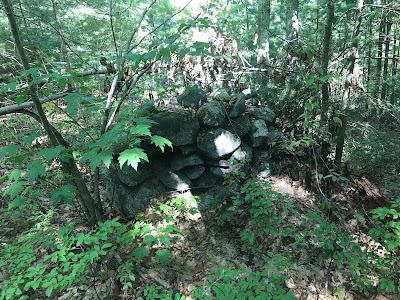Reader Keith told me about a site in Mendon and it was great going back in the woods. Thinking about seeing rock piles in the woods, after months of doing other things, the whole idea that there would be Native American ceremonial stone structures out there begins to seem like a dream. The idea that I could take a few steps up a hill and see a collection of structures facing west, spread out down the side of the hill, seemed unreal. Not because I didn't trust the information but because the whole idea is so alien to this modern, currently coronavirus-focused, culture. But you step into the woods and there the rock piles are - still and peaceful. And you think: these may still be around, even if America passes away.
So it was with these thoughts that I followed Keith's directions [enter from Asylum Street, take the northernmost trail] and within 10 minutes found myself in a wonderful collection of rectangular mounds with hollows.
There were also satellite "marker" piles, near each of the larger mounds. Generally the site was undisturbed and the piles were in excellent shape. If you head downhill and upstream to a little valley northeast of the summit, there are other mounds down in there and, at the headwater, a different sort of mound, larger and [seemingly] older.
At first, a glimpse of a few piles near the summit lets me know I am getting into it. Then, this rock on rock seems to signal a "final approach", as we get to larger piles.
This was perhaps the largest of the mounds that are scattered across the northern slope near the summit. The site "faces" northwest. Just downhill from this first mound, was a small boulder in line with a marker pile:
And here are several other mounds:

Beautifully made, and in excellent shape. So much so that you begin to think the hollow in the pile never had a covering of stones. Perhaps the pile was covered with brush?
Added Later: This photo shows a good example of a right-angled (90 degree) corner in a mound. This is why I call the mounds "rectangular". Not all corners need to be present. It was significant to me that Doug Harris instructed people in Carlisle who were building a viewing platform near a rock pile site to avoid making corners in the platform. That idea was not part of the culture of the people who made this site in Mendon, nor generally in inland Middlesex.
Here is another, with a larger, longer pile in the background:
Here is a boulder connected to a rectangle with hollows:
And you follow it down and to the right (east) and find other rectangular mounds next to the "crease" of water flow:
Is there anything more marvelous than an ancient ruin, poking up through the hay-scented ferns?
The slope continues:
Following the gully up hill, one finds:
Seen from above, this is a different style of mound: larger, not so rectangular, and more broken down.
To me this seems older than the fresh piles on the summit. Which fits into a theory, that "water loving" burials are older than "sky loving" ones. This site, sitting at one of the highpoints feeding into the Blackstone River, began in the valley and, over time, went higher on the hill. That is how I imagin it developed. Generally in various places, the higher on the hill, the better the condition of the rock piles.
Heading back, a few other things, seen in passing:
This one looks like an effigy:
Thanks Keith!




















It sure is a wonderful site! glad you had a chance to see it! Thanks!
ReplyDeleteKeith